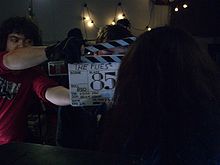- Clapperboard
-
This article is about the equipment used during filming. For the television programme, see Clapperboard (TV series).
A clapperboard is a device used in filmmaking and video production to assist in the synchronizing of picture and sound, and to designate and mark particular scenes and takes recorded during a production. The sharp "clap" noise that the clapperboard makes can be identified easily on the audio track, and the shutting of the clapstick can be identified easily on the separate visual track. The two tracks can then be precisely synchronised by matching the sound and movement. Other names for the clapperboard include clapper, clapboard, slate, slate board, sync slate, time slate, sticks, board, and marker.
When a movie's sound and picture are out of synchronization, this is known as lip flap.
Overview
The clapperboard or clapboard slate is the combination of the chalkboard slate that held information identifying the next scene and the clapstick which was used to align sound and picture. In the early days of film, one person would hold a slate for the camera with the scene information, while another clapped two hinged sticks together in front of the camera.[1] The combination of the two into one unit made it much easier for just one person to handle both jobs.
Traditional clapperboards used to consist of a wooden slate and a hinged clapstick attached to the top of the slate. However, modern clapperboards now generally use a pair of wooden sticks atop whiteboard or translucent acrylic glass slates which do not require additional lighting from the camera side to be legible. Some versions are also backlit. Smart slates or digislates are electronic SMPTE time code versions with LED numbers. The clapsticks traditionally have diagonally interleaved lines of black and white to ensure a clear visual of the clap in almost any lighting conditions, but in recent years sticks with calibrated color stripes have also become available. In some productions, particularly those created in the digital domain, electronically superimposed versions of a clapperboard have supplanted the real thing.
In use, the details of the next take are written on the slate of the clapperboard.
This typically includes the date, the production title, the name of the director, the name of the director of photography (DP) and the scene information - which follows two popular systems: American - scene number, camera angle and take number; e.g. scene 24, C, take 3; European - slate number, take number (with the letter of the camera shooting the slate if using multiple-camera setup); e.g. slate 256, take 3C. Often the European system will also include the scene number; however, a separate continuity sheet that maps the slate number to the scene number, camera angle and take number may be used if the scene number is not included on the slate. This is generally not as great a concern with short films, however. The clapper loader (or 2nd AC) is generally responsible for the maintenance and operation of the clapperboard, while the script supervisor is responsible for determining which system will be used and what numbers a given take should have. While these are usually fairly obvious once a system has been agreed upon, the script supervisor is usually considered the final arbiter in the event of an unclear situation.
A verbal identification of the numbers, known either as "voice slate" or "announcement", occurs after sound has reached speed. At the same time or shortly thereafter, the camera will start running, and the clapperboard is then filmed briefly at the start of the take and the clapsticks are clapped sharply as soon as the camera has reached sync speed. Specific procedures vary depending on the nature of the production (documentary, television, feature, commercial, etc.) and the dominant camera assisting conventions of the region; therefore it is not possible to describe a definitive practice aside from the general principles.[2]
Sometimes a tail slate or end slate is filmed at the end of a take, during which the clapperboard is held upside-down. This is done when the clapperboard wasn't captured or was missing at the start of the take.
The clapper (two sticks hinged together) may have been invented by Frank Thring (father of actor Frank Thring), who was head of Efftee Studios in 1920s Melbourne, Australia.[3]
The current digital slate was invented by Matthew L. Davies, holder of US patent number 6831729.[4]
References
Categories:- Film and video technology
Wikimedia Foundation. 2010.




